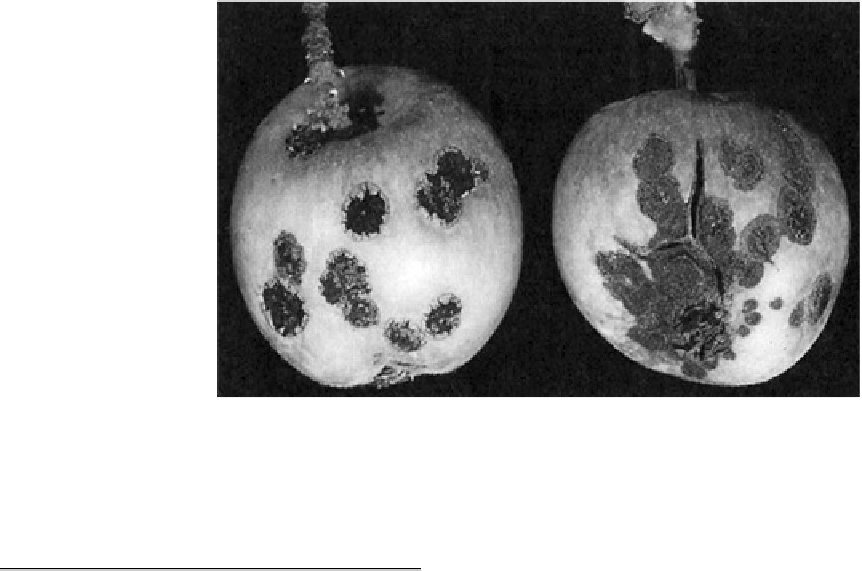Biology Reference
In-Depth Information
Fig. 1
Apple scab on leaf
and fruit
applied to potato soil. Somewhat resistant varie-
ties include Menonimee, Ontario, Cayuga, and
Seneca.
1819 and was recognized in New York and New
Jersey in 1834, apparently having come here with
some European imports.
Symptoms
The first symptom of scab on leaves
is a dull smoky area that changes to an olive-
drabmoldyspot,1/4inchormoreindiameter,
without a sharp outline. Sometimes the leaf is
raised or domed in the vicinity of the spot;
sometimes it turns brown and drops prema-
turely. Similar spots may be formed on blossom
pedicel, calyx, and petals, followed by dropping
of young fruit. Scabby lesions sometimes appear
on twigs, but are less common. On fruits, spots
are small, more or less raised, rounded, dark
olive areas (see
Fig. 1
). As they increase in
size, the cuticle ruptures to form a white rim
around a dark, velvety center, and still later the
center may be raised, corky, and tan in color,
after dark mycelium and spores have
disappeared. Lesions are usually most abundant
near calyx end of fruit; if they are too numerous,
the fruit splits.
Life History
The fungus winters in dead fallen
leaves, producing small, dark, flask-shaped peri-
thecia and, toward spring, asci with eight brown
ascospores, unequally two-celled, with the upper
cell wider than the lower (
Fig. 2
). The ascospores
mature about the time blossoms show pink, and
are forcibly expelled during warm spring rains.
Each ascus elongates, protrudes its tip through
the mouth of the perithecium, and explodes its
Venturia
Ascomycetes, Pleosporales,
Venturiaceae
Perithecia setose, often only near apex, papillate;
paraphyses absent; spores unequally two-celled,
olive.
Venturia cerasi On cherry and European plum,
perhaps a strain of the peach scab fungus but not
infecting peach.
Venturia inaequalis (Anamorph,
Spilocaea
pomi
).
Apple Scab
,
Scurf
,
Black Spot
, general
on apple except in far South, widespread on
crabapple; reported also on mountain-ash and
hawthorn, but probably other species of
Fusicladium
infect these hosts. Scab is the
world's top-ranking apple disease and is probably
coextensive with the host. In this country it takes
a fourth or more of the crop in a favorable scab
year, the average national loss running around
8 %, or over 10 million bushels. Scab is some-
what less important in the South and in irrigated
sections of Washington, but it is important in the
humid coastal areas (
Fig. 1
). The pathogen was
first described and named by Fries in Sweden in


